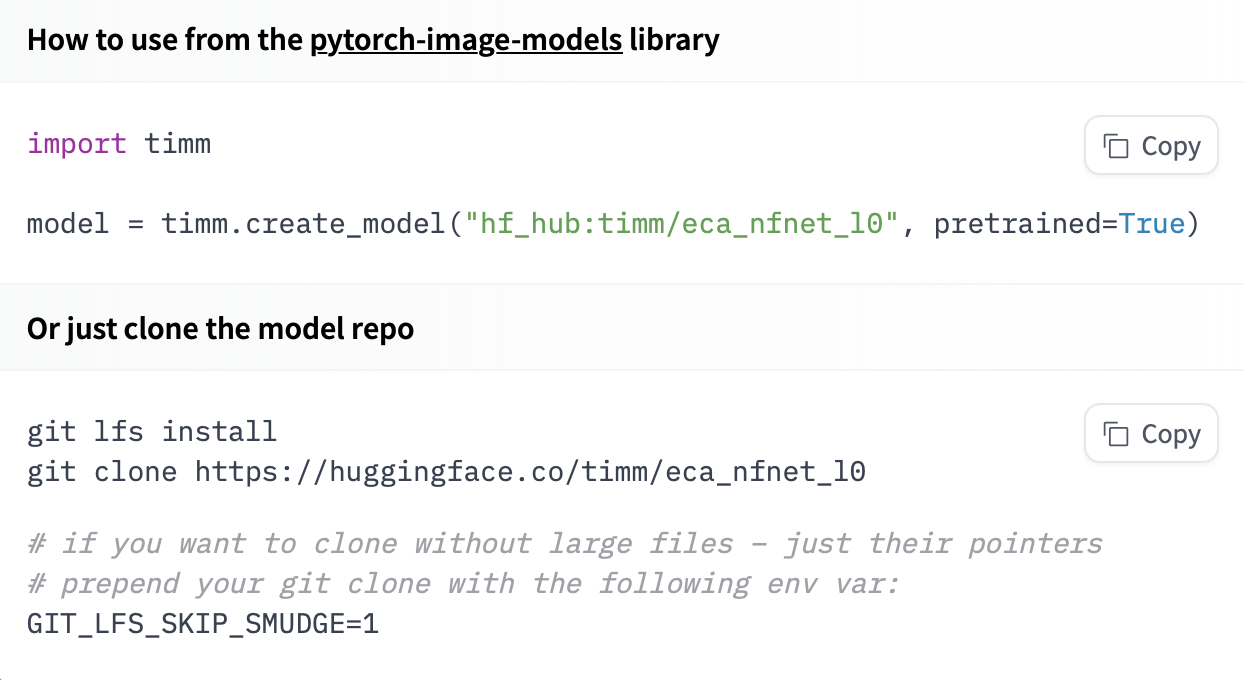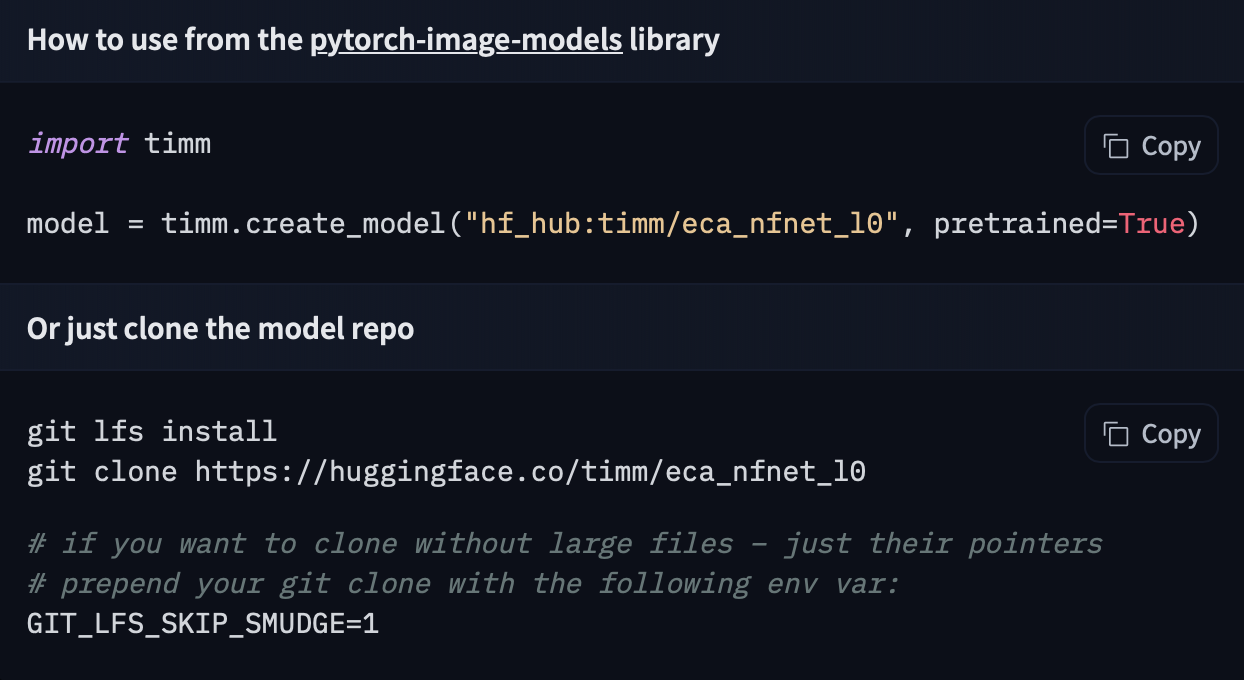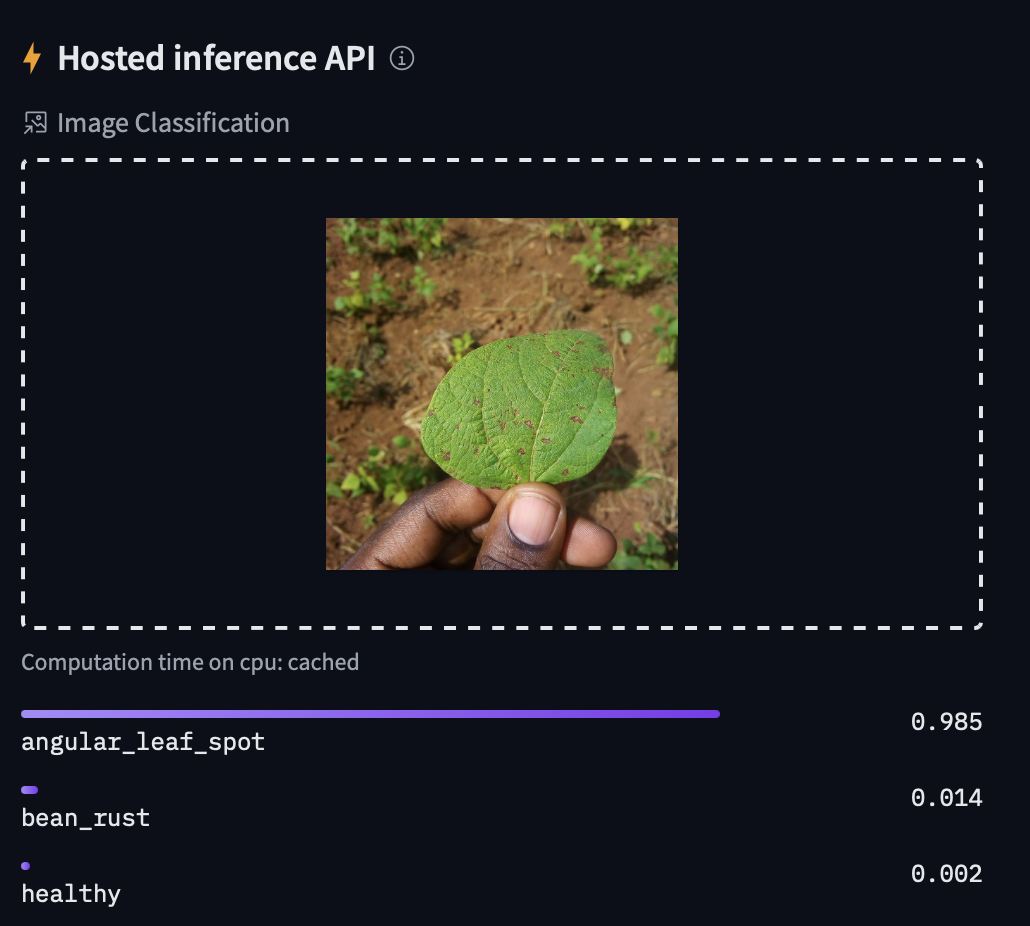Hub documentation
Using timm at Hugging Face
Using timm at Hugging Face
timm, also known as pytorch-image-models, is an open-source collection of state-of-the-art PyTorch image models, pretrained weights, and utility scripts for training, inference, and validation.
This documentation focuses on timm functionality in the Hugging Face Hub instead of the timm library itself. For detailed information about the timm library, visit its documentation.
You can find a number of timm models on the Hub using the filters on the left of the models page.
All models on the Hub come with several useful features:
- An automatically generated model card, which model authors can complete with information about their model.
- Metadata tags help users discover the relevant
timmmodels. - An interactive widget you can use to play with the model directly in the browser.
- An Inference API that allows users to make inference requests.
Using existing models from the Hub
Any timm model from the Hugging Face Hub can be loaded with a single line of code as long as you have timm installed! Once you’ve selected a model from the Hub, pass the model’s ID prefixed with hf-hub: to timm’s create_model method to download and instantiate the model.
import timm
# Loading https://huggingface.co/timm/eca_nfnet_l0
model = timm.create_model("hf-hub:timm/eca_nfnet_l0", pretrained=True)If you want to see how to load a specific model, you can click Use in timm and you will be given a working snippet to load it!




Inference
The snippet below shows how you can perform inference on a timm model loaded from the Hub:
import timm
import torch
from PIL import Image
from timm.data import resolve_data_config
from timm.data.transforms_factory import create_transform
# Load from Hub 🔥
model = timm.create_model(
'hf-hub:nateraw/resnet50-oxford-iiit-pet',
pretrained=True
)
# Set model to eval mode for inference
model.eval()
# Create Transform
transform = create_transform(**resolve_data_config(model.pretrained_cfg, model=model))
# Get the labels from the model config
labels = model.pretrained_cfg['label_names']
top_k = min(len(labels), 5)
# Use your own image file here...
image = Image.open('boxer.jpg').convert('RGB')
# Process PIL image with transforms and add a batch dimension
x = transform(image).unsqueeze(0)
# Pass inputs to model forward function to get outputs
out = model(x)
# Apply softmax to get predicted probabilities for each class
probabilities = torch.nn.functional.softmax(out[0], dim=0)
# Grab the values and indices of top 5 predicted classes
values, indices = torch.topk(probabilities, top_k)
# Prepare a nice dict of top k predictions
predictions = [
{"label": labels[i], "score": v.item()}
for i, v in zip(indices, values)
]
print(predictions)This should leave you with a list of predictions, like this:
[
{'label': 'american_pit_bull_terrier', 'score': 0.9999998807907104},
{'label': 'staffordshire_bull_terrier', 'score': 1.0000000149011612e-07},
{'label': 'miniature_pinscher', 'score': 1.0000000149011612e-07},
{'label': 'chihuahua', 'score': 1.0000000149011612e-07},
{'label': 'beagle', 'score': 1.0000000149011612e-07}
]Sharing your models
You can share your timm models directly to the Hugging Face Hub. This will publish a new version of your model to the Hugging Face Hub, creating a model repo for you if it doesn’t already exist.
Before pushing a model, make sure that you’ve logged in to Hugging Face:
python -m pip install huggingface_hub hf auth login
Alternatively, if you prefer working from a Jupyter or Colaboratory notebook, once you’ve installed huggingface_hub you can log in with:
from huggingface_hub import notebook_login
notebook_login()Then, push your model using the push_to_hf_hub method:
import timm
# Build or load a model, e.g. timm's pretrained resnet18
model = timm.create_model('resnet18', pretrained=True, num_classes=4)
###########################
# [Fine tune your model...]
###########################
# Push it to the 🤗 Hub
timm.models.hub.push_to_hf_hub(
model,
'resnet18-random-classifier',
model_config={'labels': ['a', 'b', 'c', 'd']}
)
# Load your model from the Hub
model_reloaded = timm.create_model(
'hf-hub:<your-username>/resnet18-random-classifier',
pretrained=True
)Inference Widget and API
All timm models on the Hub are automatically equipped with an inference widget, pictured below for nateraw/timm-resnet50-beans. Additionally, timm models are available through the Inference API, which you can access through HTTP with cURL, Python’s requests library, or your preferred method for making network requests.


curl https://api-inference.huggingface.co/models/nateraw/timm-resnet50-beans \
-X POST \
--data-binary '@beans.jpeg' \
-H "Authorization: Bearer {$HF_API_TOKEN}"
# [{"label":"angular_leaf_spot","score":0.9845947027206421},{"label":"bean_rust","score":0.01368315052241087},{"label":"healthy","score":0.001722085871733725}]Additional resources
- timm (pytorch-image-models) GitHub Repo.
- timm documentation.
- Additional documentation at timmdocs by Aman Arora.
- Getting Started with PyTorch Image Models (timm): A Practitioner’s Guide by Chris Hughes.